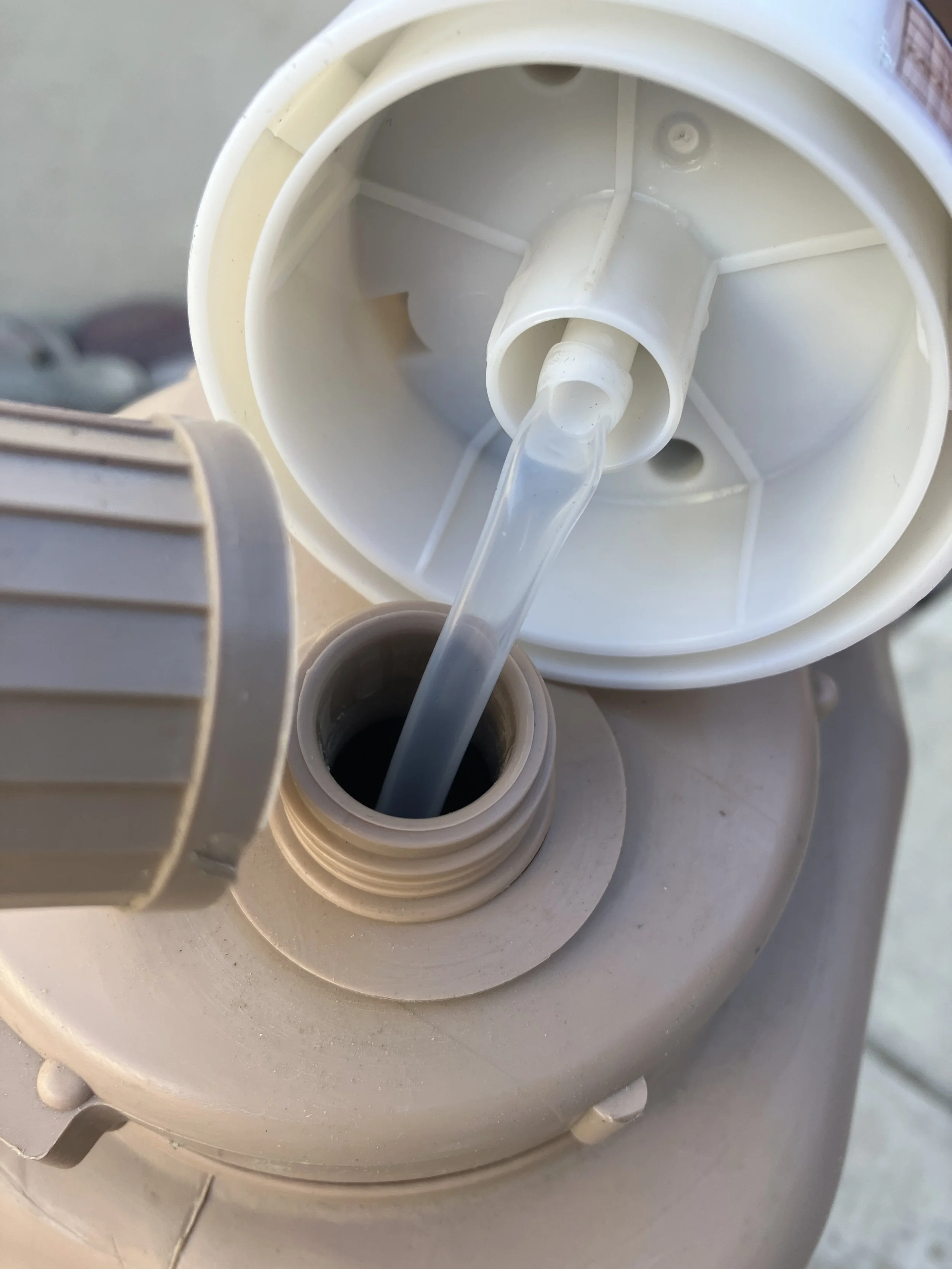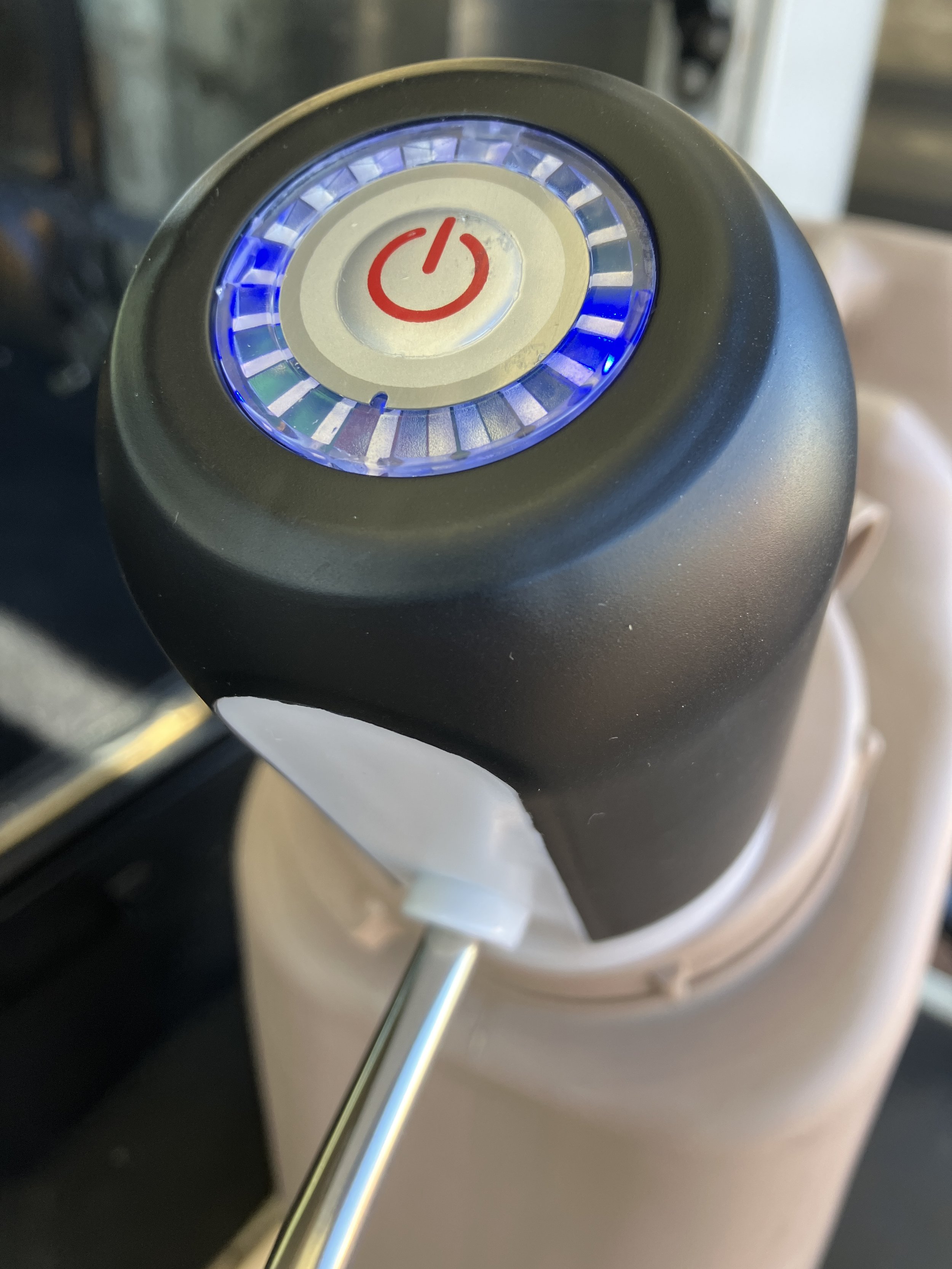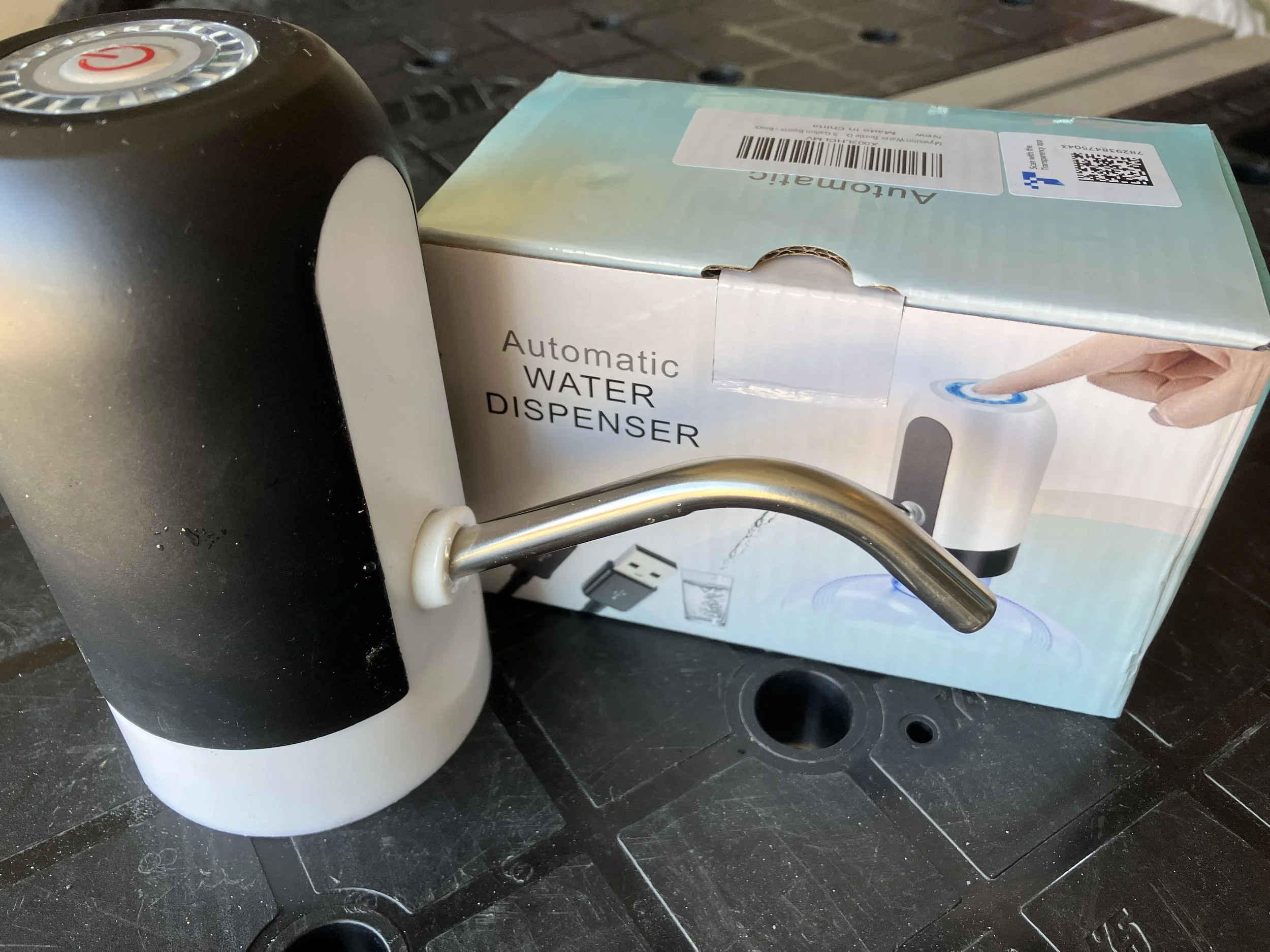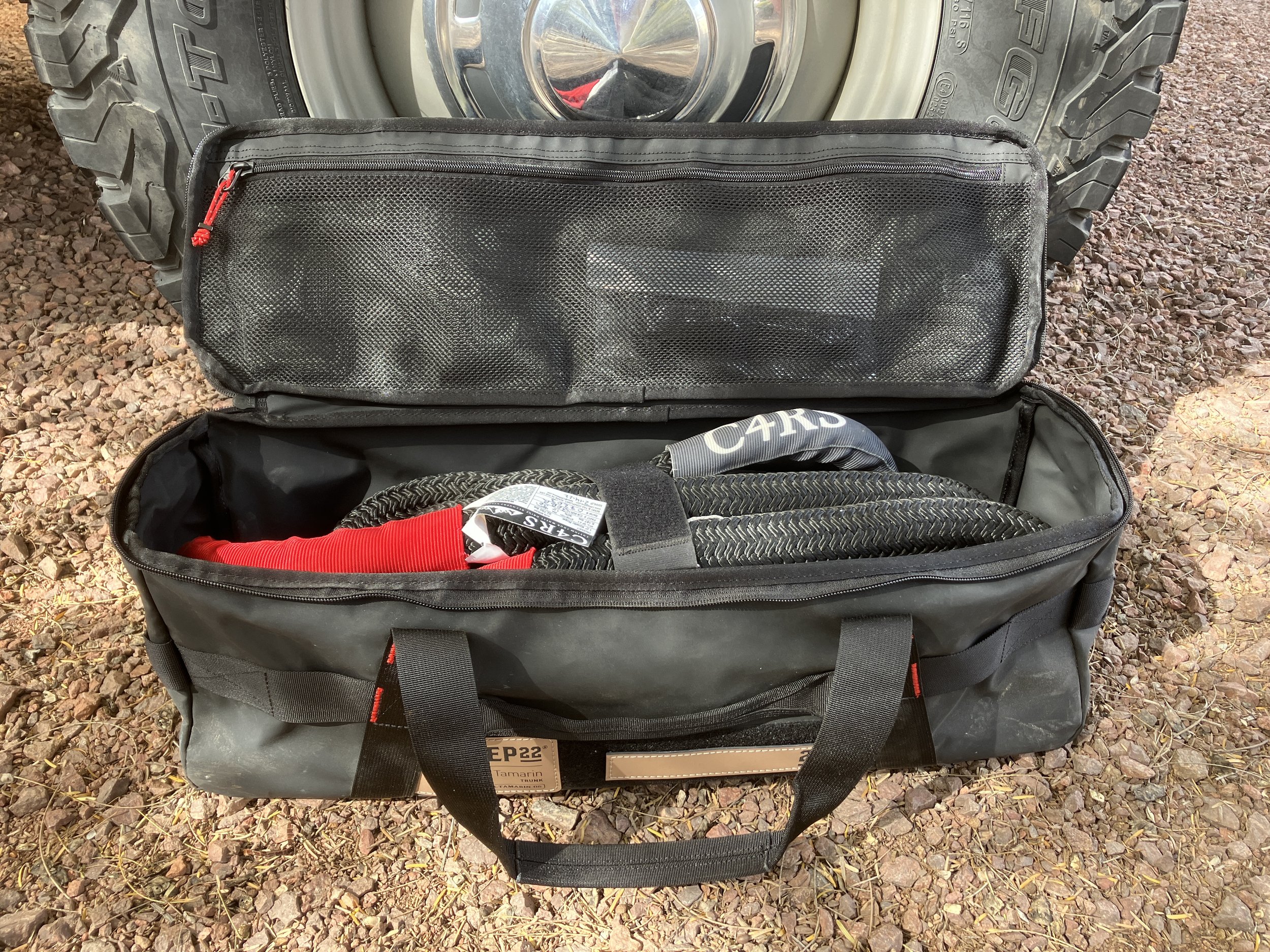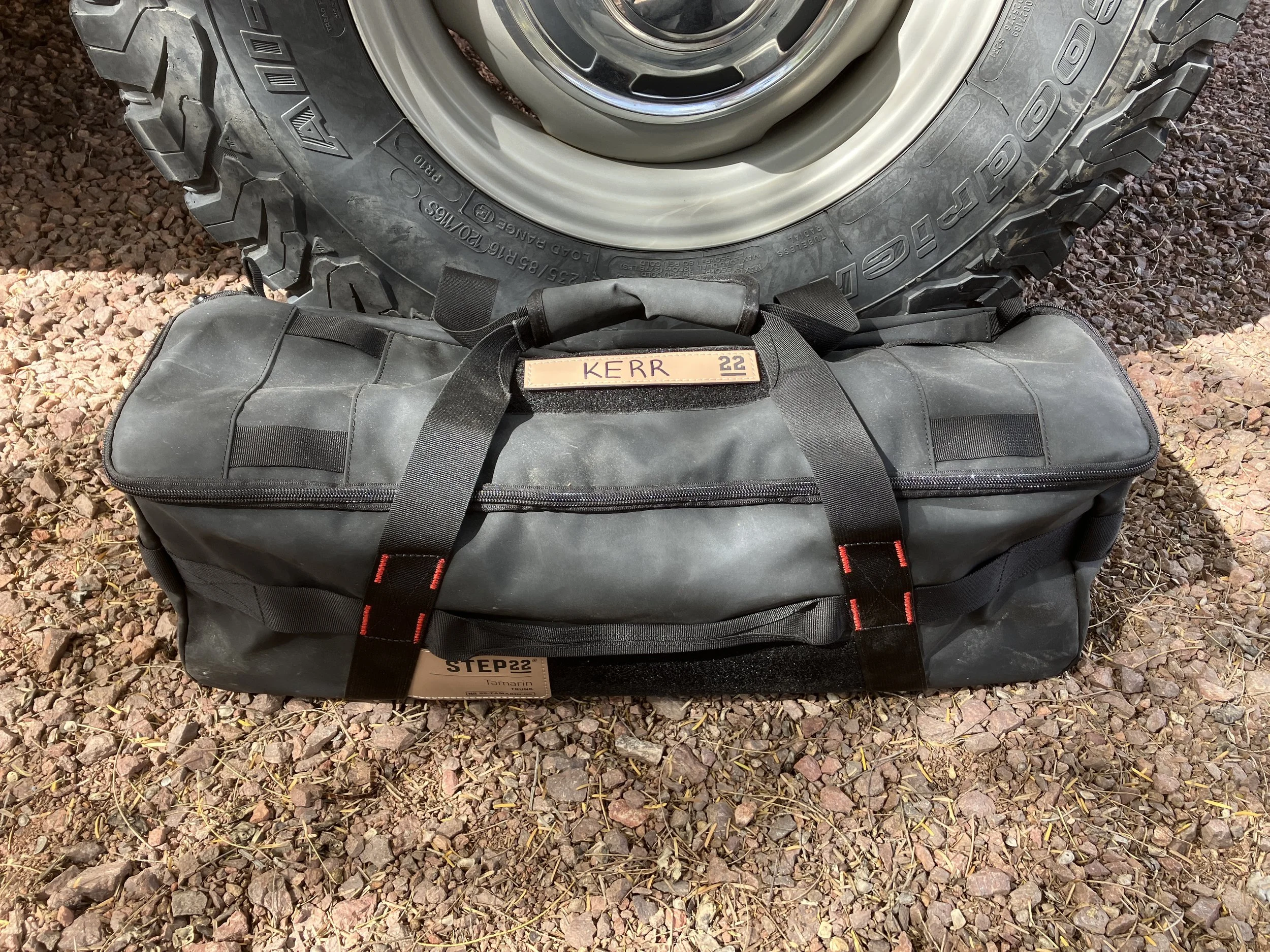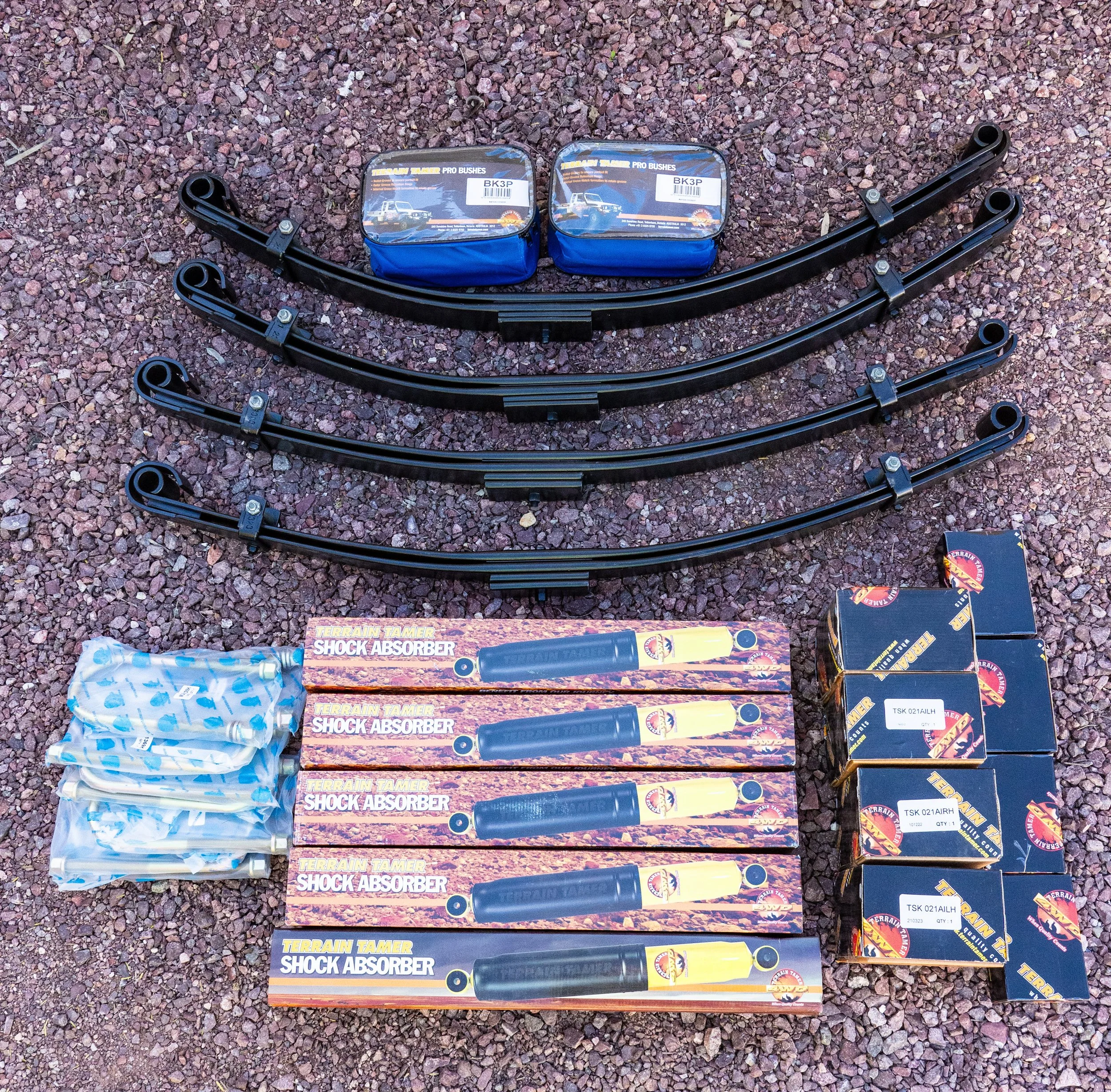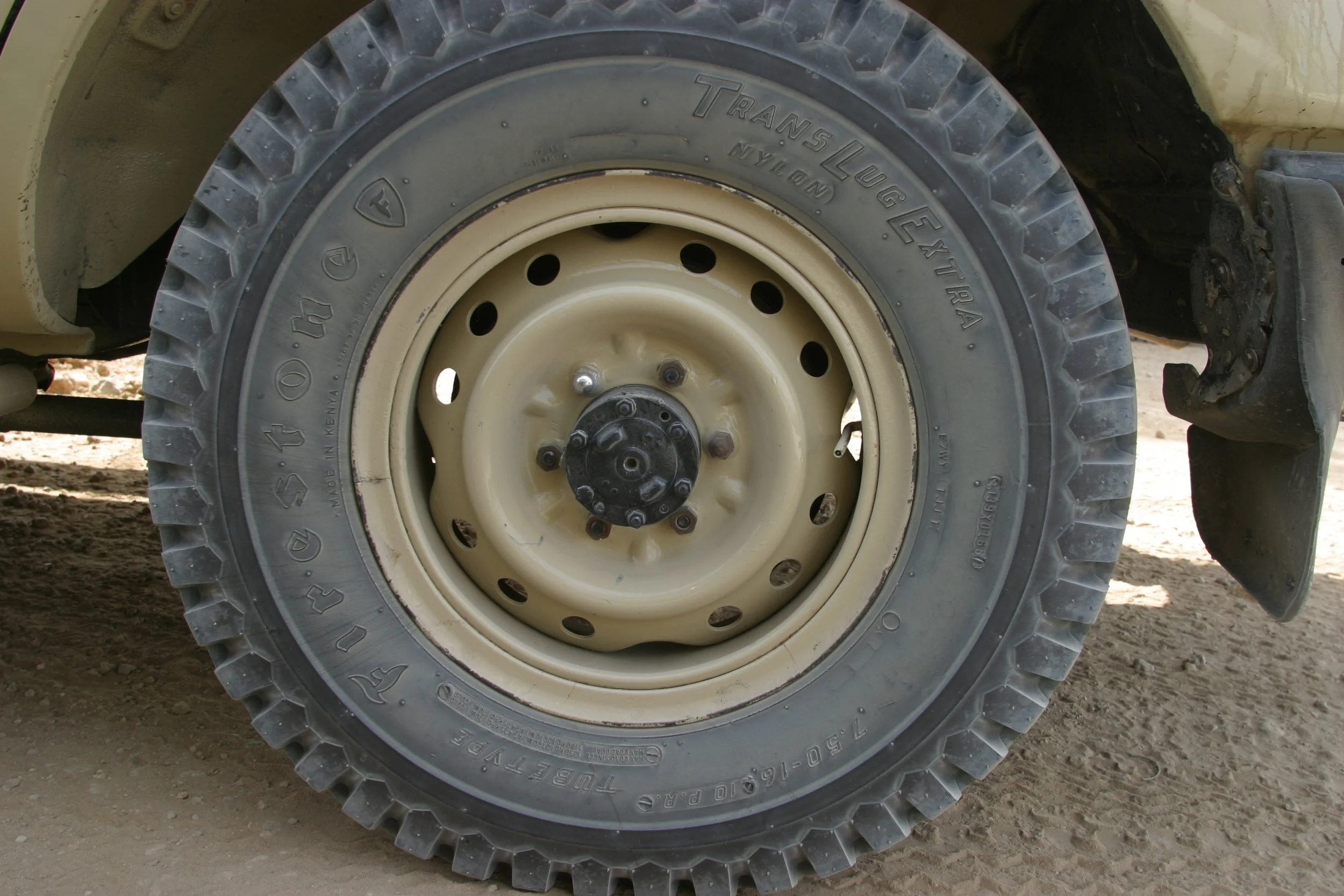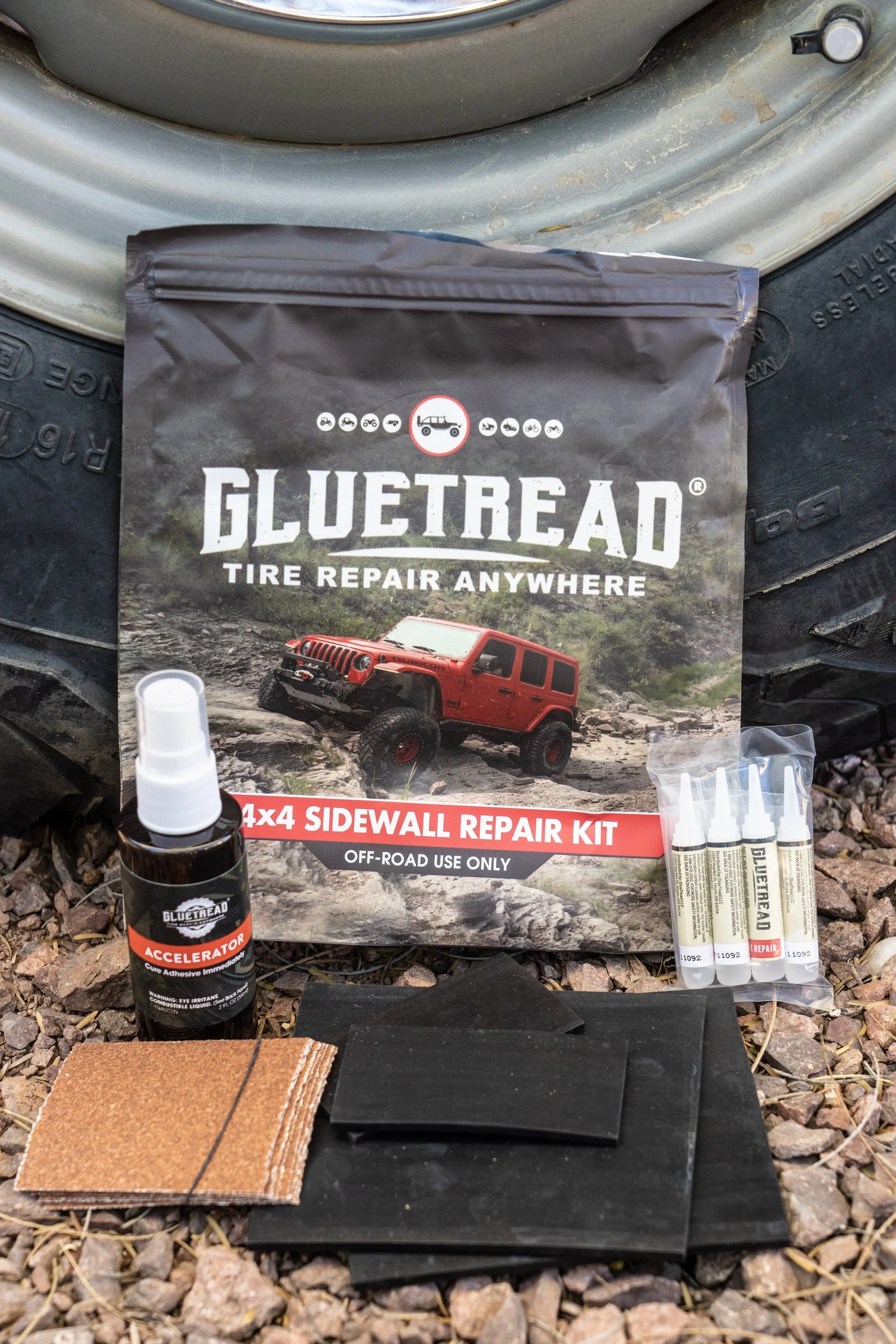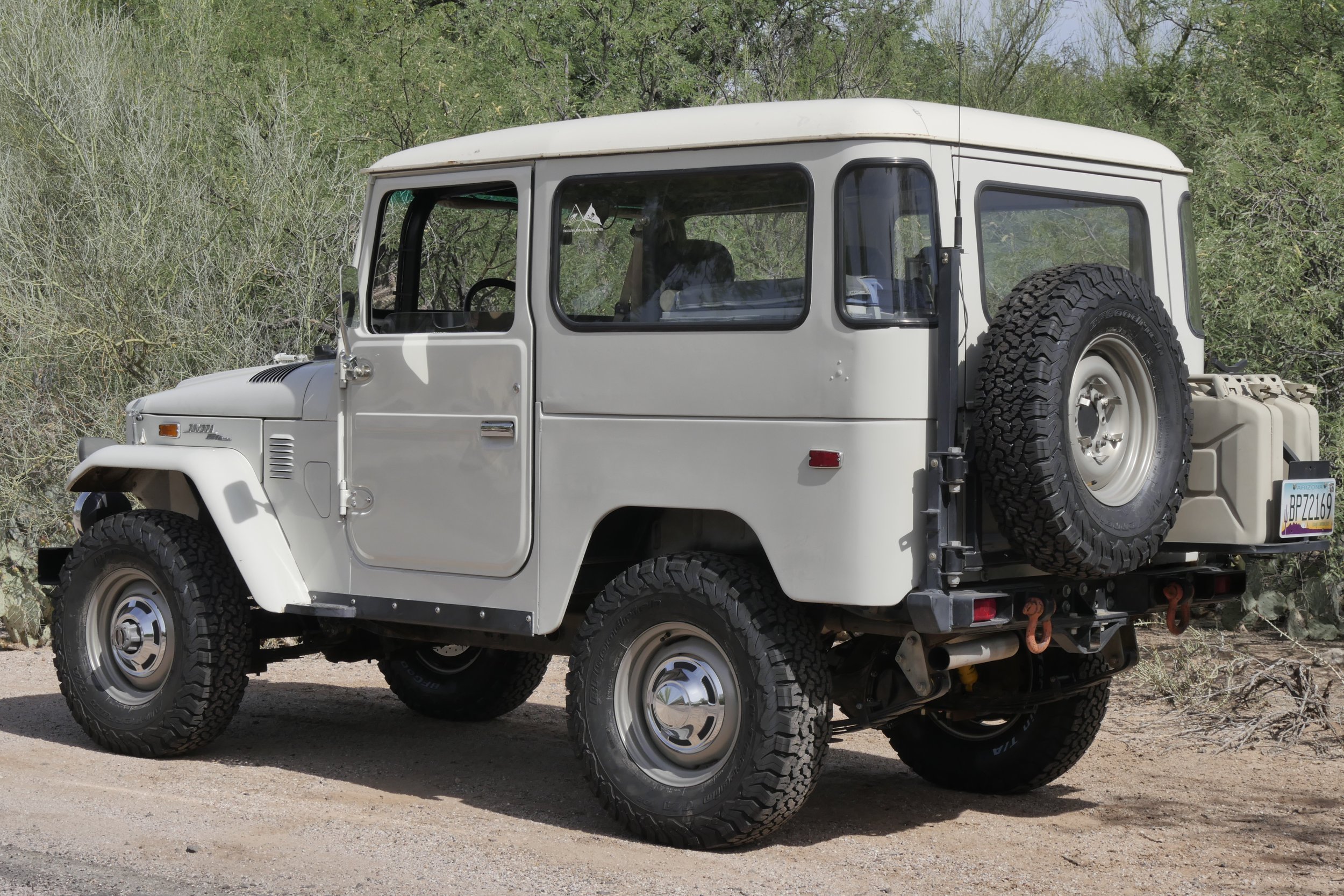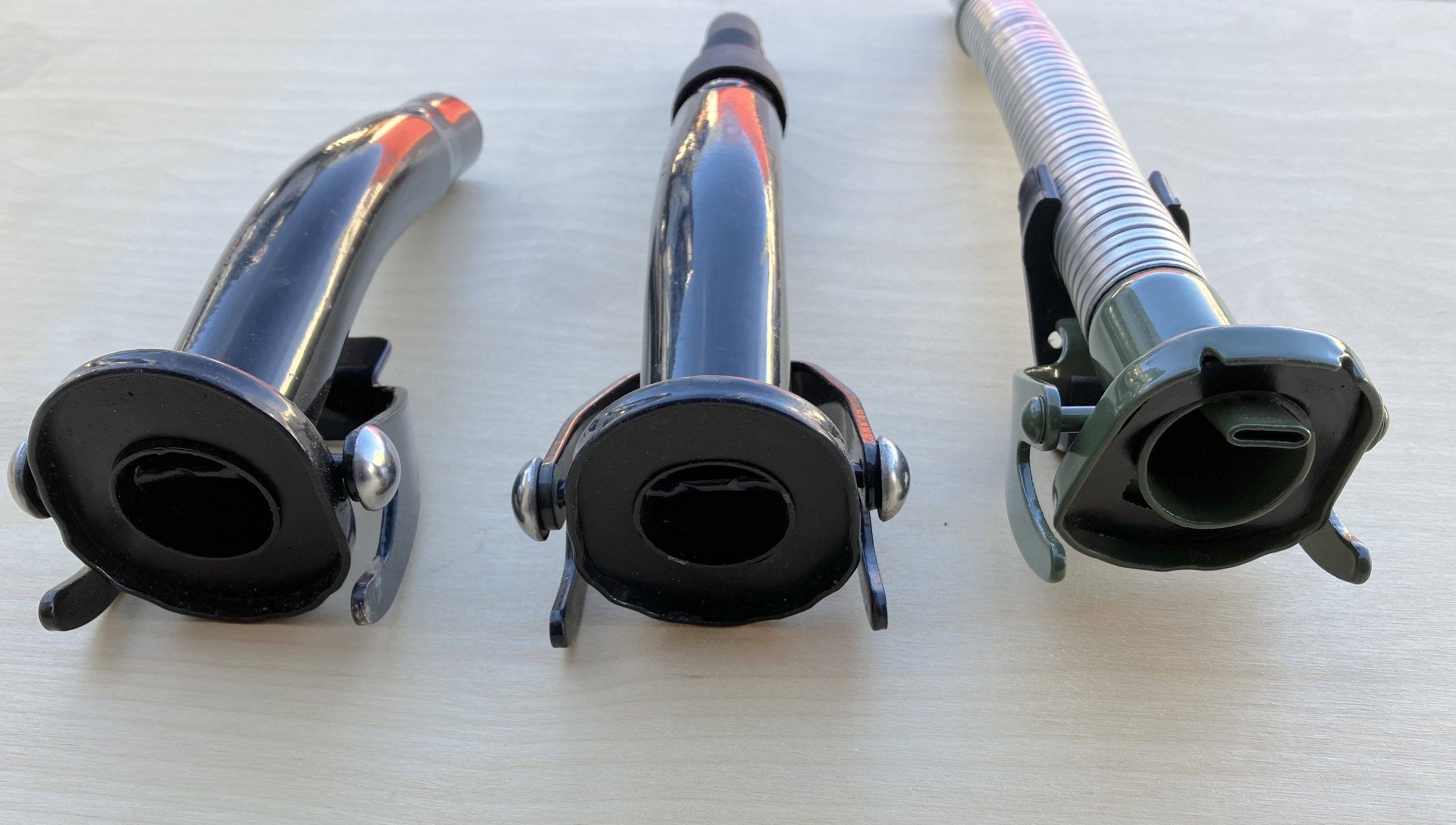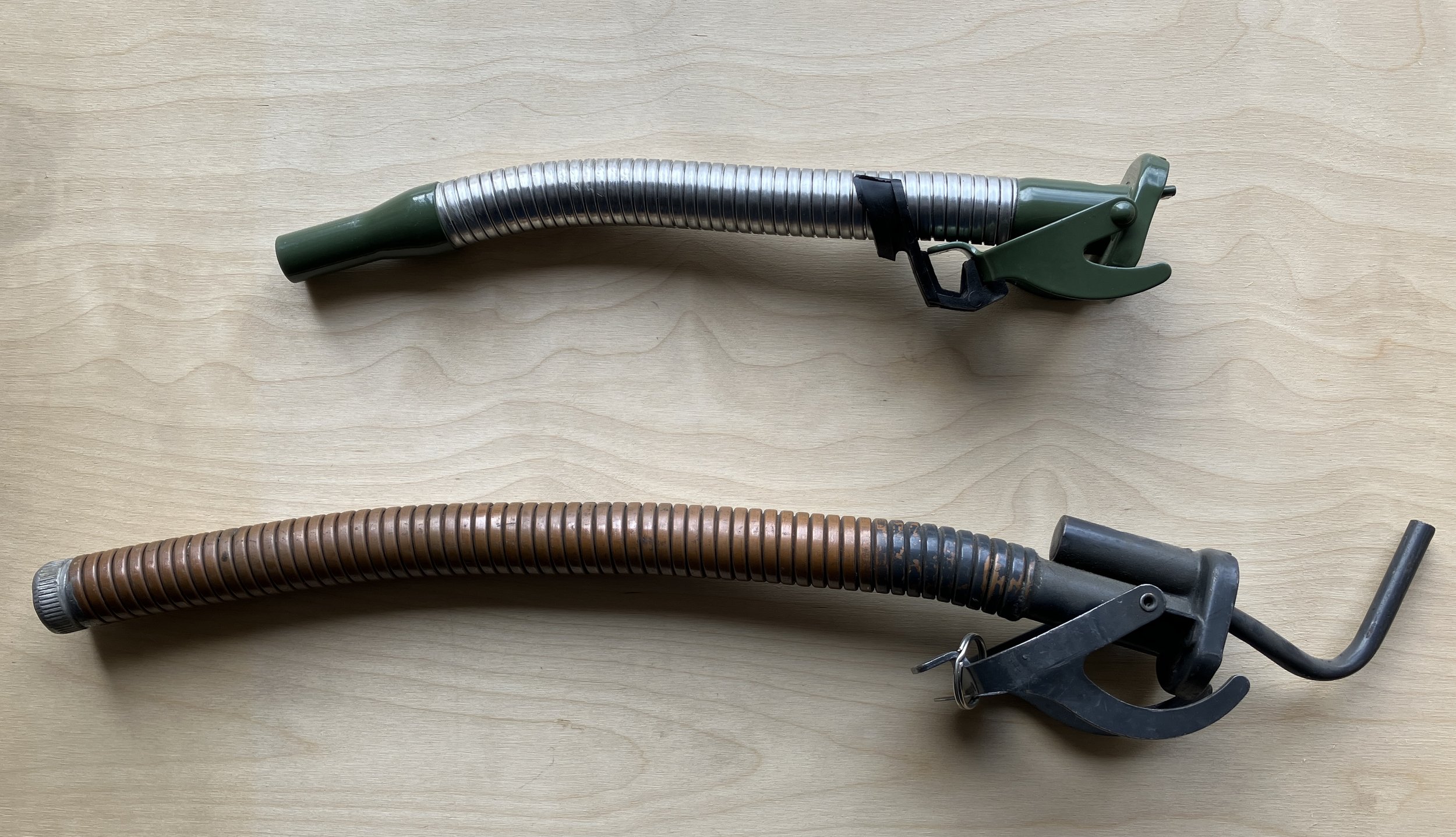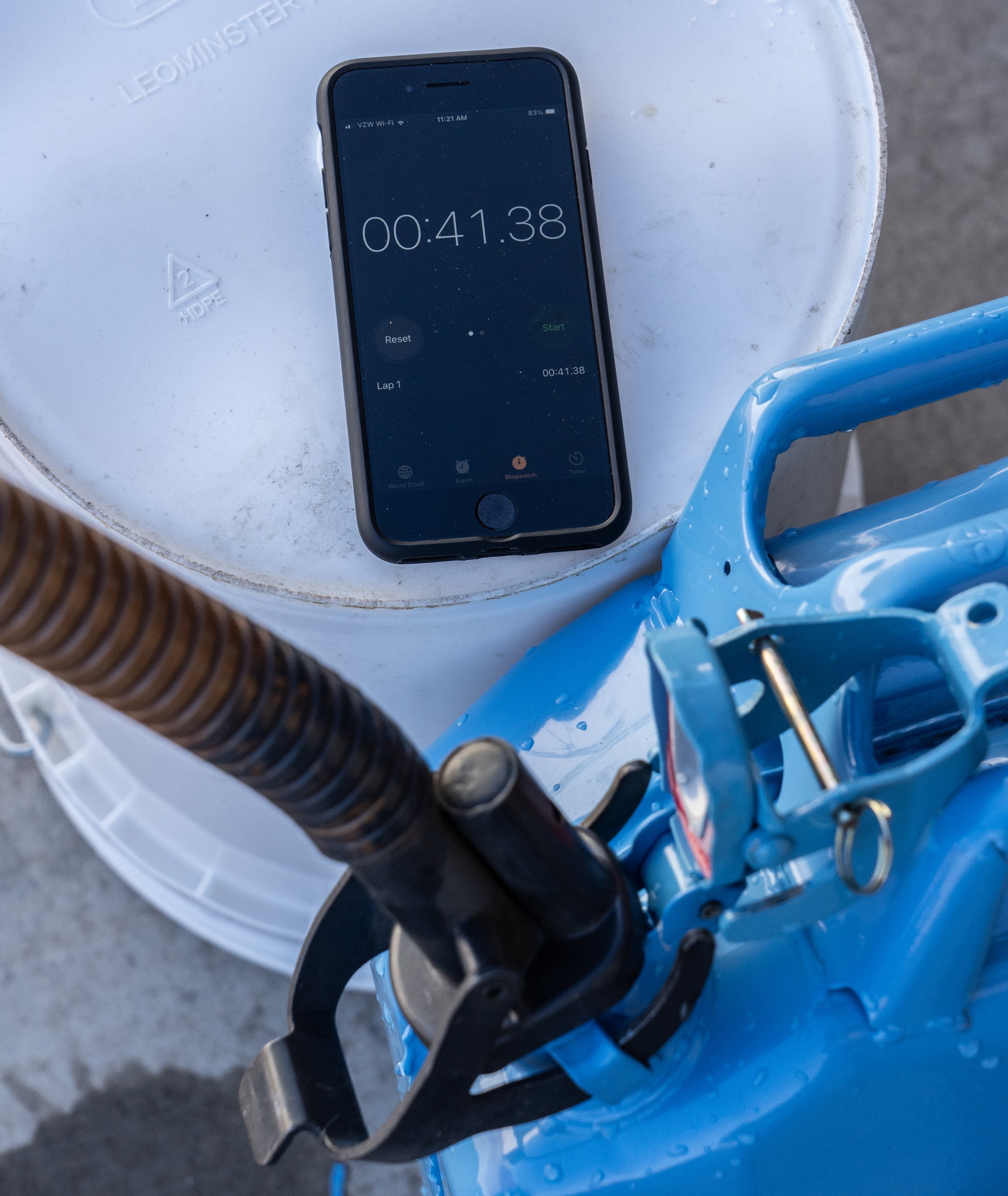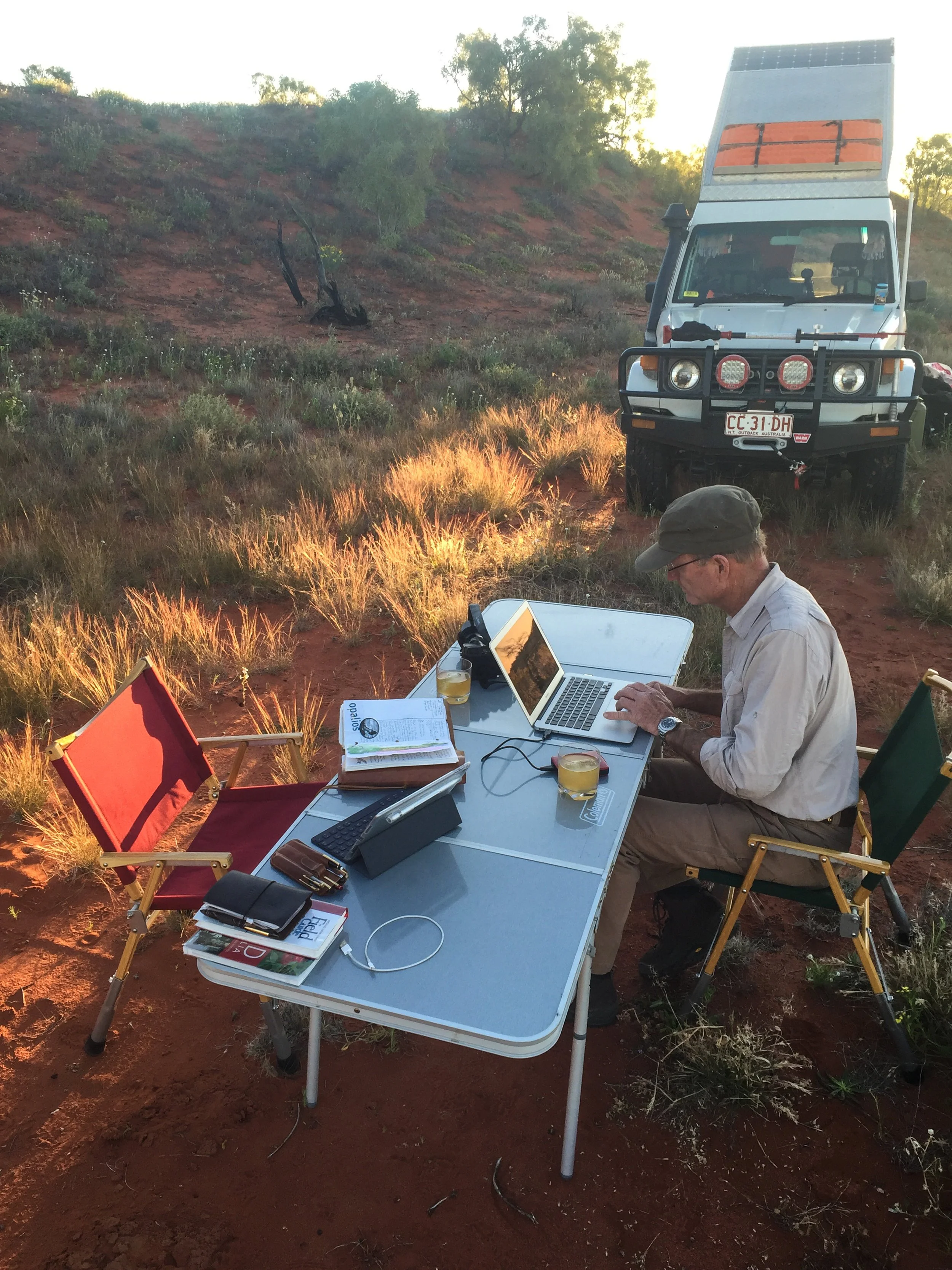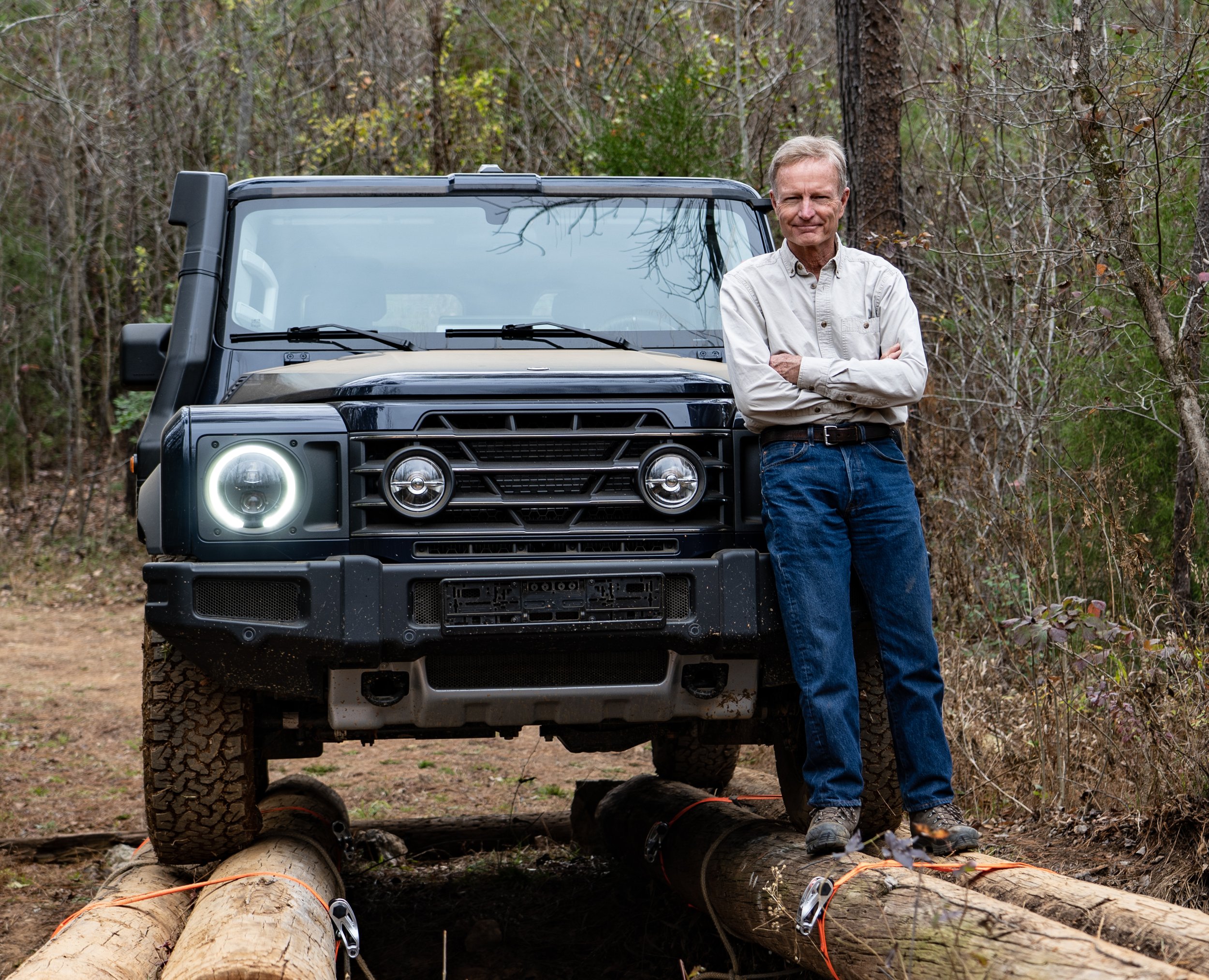
Overland Tech and Travel
Advice from the world's
most experienced overlanders
tests, reviews, opinion, and more
A (very) affordable water pump for the Scepter can
I wrote some time ago about what I think is the highest-quality manual pump for the Scepter water can (here). As reliable as the Fynspray pump is, it does require modifying a spare cap to accept the unit.
Recently someone alerted me to a rechargeable electric pump on Amazon that costs less than $16. Called then Myvision Automatic Drinking water Pump, it’s designed to fit the common 2.5 to 5-gallon office-dispenser-type water bottles supplied by various franchises.
However, fortuitously, the inner flange also fits quite snugly inside the small cap opening on top of the Scepter’s main cap.
The pump recharges via USB; an LED around the top switch glows red until the unit is charged, and glows blue while on.
I found the flow to be easily the equivalent of the Dometic GO pump, although the Myvision lacks such features as the handy auto shut-off and the equally useful LED that illuminates the container. The ad—which is sprinkled with a bit of garbled Chingrish—says it’s guaranteed for two years. The battery does not appear to be replaceable. Nevertheless a tempting bargain if you like an electric dispenser. Find it here.
Anti Access? Or just Pro Habitat?
This photo appeared several years ago in a full-page spread in the New York Times and other newspapers.
In the February/March issue of OVR magazine—a fine publication to which I contribute regularly—my colleague and friend Chris Collard published an article with the attention-grabbing, all-caps headline of LAND GRAB. The gist of the article was that well-funded organizations are in the process of blocking off more and more vehicular access to public land, and that an “alarming” amount of such land in the U.S. is designated as wilderness, thus “lost” to everyone except those “traversing it on foot.”
Chris wrote, “Some refer to the ‘more wilderness’ advocates as environmentalists. I believe a better term is the Anti-Access Crowd (AAC).”
As it happens, I am one of those people. So I thought I would offer some perspective, and, since I doubt OVR would be willing to print it, I’ll leave it here to be shared or condemned. Chris and I agree on a lot of things and disagree on a few, so I hope our friendship will survive this example of the latter.
I’ll state up front that Chris notes his support for some wilderness areas. However, he makes it clear he would prefer a lot less than there is now.
Chris writes that he believes, “The folks driving the Wilderness Act had legitimate science supporting their position, and valid concerns . . .” but then claims that “the arena has drastically shifted from a genuine effort to protect this nation’s wild places to a game of deep-pocket monopoly . . .”
Chris then notes that there are now more than 800 designated wilderness areas in the U.S. Continuing, “To put this in perspective, the public has lost access to 112 million acres of land. This is an area larger than the state of California, plus Massachusetts. Another 12 million is in the crosshairs as Wilderness Study Areas. Alarming, right?”
Well, yes, it is alarming—but not in the way Chris thinks. Let’s put those figures into context.
First, over half of all designated U.S. wilderness—57 million acres—is in Alaska. That leaves about 54.5 million acres of wilderness in the lower 48.
Alarming? You bet it is. Because those 48 states comprise 1.9 billion acres, not counting water. That means less than three percent of the land in the contiguous United States is protected in perpetuity (we hope) against mining, logging, and road building. If we include Alaska the figure is still under five percent. Is it really a tragic “land grab” to preserve one out of every twenty acres in our country in something reasonably approaching its natural, pre-corporate-resource-extraction state? I don’t believe so. Russia has no wilderness areas. China has no wilderness areas. The concept is American, through and through, and I am proud of it.
How evident is this pride among the general public, and how strong is the support for wilderness? When the U.S. Forest Service conducted its own nationwide poll, it found that 69.8 percent of respondents were in favor of more wilderness in their own states. Among non-metropolitan residents, 43.5 percent were in favor of more wilderness, and 34 percent said the current amount was about right. Just 7.4 percent thought too much had been protected.
Zogby International found that support for wilderness cuts across party lines, noting that 54 percent of Republicans support more wilderness in their own state, as do 66 percent of Independents and 75 percent of Democrats. Another poll tallying those who support more wilderness in their own states found the following: Alaska, 73 percent; Utah, 80 percent; Nevada, 56 percent; New Mexico, 57 percent; Vermont, 73 percent. It seems the “Anti Access Crowd” comprises a significant majority of the American public—the people who own that land.
In fact the entire “locked out” argument completely misconstrues the intent of the Wilderness Act, which was to preserve areas where “the earth and its community of life are untrammeled by man, where man himself is a visitor who does not remain.” In other words, a wilderness is an area where our own recreational convenience is considered secondary to the welfare of the habitat and the wildlife. Again, a concept in which we should take exceptional pride.
It’s important to note that, with very rare exceptions, the 12 million acres Chris describes as “in the crosshairs” as potential wilderness is already roadless—that’s one reason (but only one) why it’s under consideration. You and your 4x4 can’t be “locked out” of an area into which you can’t drive anyway. If every single one of those 12 million acres winds up being designated wilderness—a virtual impossibility—it would raise by less than half a percentage point the land already protected.
Chris goes on to note the numerous road closures in National Forests in recent decades due to “pressure,” as though those were somehow part of the Anti Access Crowd’s land grab. In fact those closures are almost exclusively the result of drastic budget cuts that have affected all our land management agencies—and if you want to know which side of the congressional aisle those cuts came from, just look up the voting records of your representatives in Washington.
Chris states that wheelchairs are not allowed in wilderness areas. This is patently false. From the appropriate section at fs.usda.gov: “. . . nothing in the Wilderness Act prohibits wheelchair use in a wilderness area by an individual whose disability requires its use.” In fact even certain motorized wheelchairs are allowed. I’ve lost count of the times I’ve heard, “What about the handicapped?” as an argument against roadless areas. These dog-whistle remarks invariably come from decidedly un-handicapped people. Roseann and I have had the opportunity to work with several groups of handicapped people on environmental issues. Not once—not once—have I heard such an individual or group complain because they’re not allowed to drive into wilderness areas, and several of them expressed anger at being co-opted for someone else’s argument.
This brings up another misconception: that to appreciate a wilderness one must don a 50-pound backpack and hike in 20 miles with freeze-dried food and a filed-down toothbrush. Nothing could be further from the truth. I have taken more day hikes than I can remember into the fringes of wilderness areas, content to know that in front of me is unspoiled landscape. There are hundreds of wilderness areas I will never visit, but I’m grateful they are there. Another important—nay, critical—point: Study after study has shown that wilderness areas serve as vital refugia for both animals and plants. A study published in the journal Nature noted that species in wilderness areas are half as likely to face extinction. Does it surprise anyone that wildlife prefers and does better in areas without roads?
Far from being anti-accessism run amok, protection of roadless areas is more important now than it ever has been. The proliferation of not just 4x4 trucks and SUVs, but millions of all-terrain vehicles and side-by-sides, many of them ridden or driven by owners with zero training, awareness, or care, is having a devastating impact on backcountry roads, trails, and, in far too many instances, off those trails. I was disappointed to see Chris devote just two sentences to the problem of “bad apples,” taking the usual approach that it’s a tiny percentage of users. Yet he goes on to (quite justifiably) boast about all the trail cleanup projects undertaken each year by clubs and other 4x4 groups. If the bad apples are such a tiny percentage of users, why do we need so many trail cleanup days? Anyone who spends time on trails is aware that the abuse is increasing, not decreasing. Many hundreds of miles of the trails that are closed off by land agencies are closed due to continued, rampant abuse and degradation, not because of lobbying by the “Anti Access Crowd.”
Meanwhile, I can’t remember the last time I got an email requesting my help on a trail cleanup in a wilderness area. I wonder why?
The motorized abuse of the backcountry has affected me in more ways than simple aesthetics. I am a hunter. Roseann and I try to eat as much wild game as possible because we abhor the cruelties of the U.S. corporate meat industry. In the last ten to fifteen years I have lost count of the stalks I have had ruined when a “hunter” with a rifle strapped to the handlebars of his ATV has scattered all the game nearby. And on two occasions I have had a deer in sight and was stalking close enough to make a clean shot when an ATV rider spooked it. It’s not an exaggeration to say those incidents took food out of my mouth. This is one reason I became one of the first members of Backcountry Hunters and Anglers, a group that promotes fair chase and wilderness pursuits.
Finally, I was disappointed Chris did not address a prime factor behind the loss of land for all types of backcountry recreation: population growth and development. In the last 50 years in southern Arizona we’ve lost far, far more land in which to drive and hike to unchecked urban sprawl than we have to whacko environmentalists. Perhaps we should all be working together to preserve more of all types of public land, instead of fighting among ourselves.
Let’s not ignore the fact that there are those on the lunatic fringe of the environmental movement who would ban all 4x4 use—just as there are those on the lunatic fringe of the 4x4 crowd who don’t believe wilderness areas should exist at all, who would unhesitatingly blaze trails into every one if they thought they could get away with it (I’ve seen the results). It’s up to us, the majority of intelligent people, to come together in the big gray area in the middle. There’s just one thing to remember: Once a wilderness is gone—once a road is bladed through, a mine blasted out, or trees clear-cut—it is gone forever. I’d like to hang on to what we have.
And yes, I’d be happy if we had more.
Perfect match: KERR recovery rope and Step22 Tamarin Trunk
One of my main recovery tools is a one-inch by 30-foot KERR (Kinetic Energy Recovery rope) from C4RS (just say C-fours). It's a beautiful U.S.-made product, properly labeled with its working load limit and average breaking strength. In general I prefer KERRs to snatch straps due to their better stretch, which is gentler on both the recovery vehicle and the bogged truck.
However, a KERR is also bulkier and limper and fairly weighty; dealing with one when storing is like wrestling a 30-foot-long, one-inch-thick length of overcooked spaghetti.
Recently Step22 sent me one of their Tamarin Trunks, a sturdy 8 x 8 x 24-inch zippered storage bag with a reinforced bottom. It seemed to be made for the KERR, and indeed the rope fit perfectly, with room for a pair of hard shackles as well as a couple of soft shackles. now I have everything I need for a snatch recovery in one bag. A true professional approach.
Sadly, the owner of C4RS, Steve Springs, has moved on to other endeavors, but high-quality KERRs are available from other sources such as Factor 55 (here). Step22 is here.
Terrain Tamer parabolic springs for the FJ40
A few weeks ago I wrote a technical article explaining the science behind parabolic leaf springs (here). Briefly, parabolic springs eliminate almost all of the disadvantages of standard multi-leaf springs, offering far less internal and inter-leaf friction, plus true progressive action; that is, the spring offers more and more resistance as it compresses. On top of all that, a parabolic spring weighs at least a third less than a comparable multi-leaf spring.
In the article, I lamented the lack of parabolic spring kits for the 40-series Land Cruisers, and particularly the FJ/BJ40. To my surprise (and embarrassment), a few weeks later I received an email from the owner of Terrain Tamer suspension, in Australia—a company I had actually referenced in the article. The email read, “I saw your article on parabolic springs. We manufacture a kit for the FJ40 and can ship to the U.S. I’d like to send you one and have you review it.”
Well . . . okay!
The kit arrived at our commercial mail depot while we were driving from Alaska to Tucson, so our friend Brian generously picked it up and stored it until we arrived. When I retrieved everything from his house, two things were immediately apparent: first, this is a comprehensive kit, comprising springs, shocks, a steering damper, shackles, and bushings. Second, parabolic springs are astonishingly lighter than conventional leaf springs. I’m looking forward to weighing the springs now on our FJ40 and comparing.
I’ll be documenting the conversion process in depth, first measuring ride height, compliance (RTI), handling, and subjective ride comfort. There’s little reason to doubt that the Terrain Tamer kit will transform the ride and compliance of the FJ40, while potentially removing well over a hundred pounds of unsprung weight.
Terrain Tamer is here. The full kit, at the current (extremely favorable) exchange rate, is only $1,625, although shipping will of course add a good chunk. But short of a multi-thousand-dollar bespoke coil-spring conversion, there’s nothing that will do more for the ride of a 40-series Land Cruiser.
Time for split rims to roll into the sunset
I’m astonished at how often I still read posts on various forums from those who want to swap out their tubeless tires and wheels for split rims and tubed tires. The rationale is all about the romantic aura that still clings to split rims—often glued there by those who still sell them. They’re “Heavy duty.” “Made for serious expedition use.” “You can repair and replace your tires in the bush!”
Is there substance behind the legend?
Let me put it this way: Swapping your tubeless tires and wheels for split rims and tubes because “You can changes tires in the bush!” makes as much sense as throwing away your electronic ignition system and installing a points-style distributor because you can set the gap with a matchbook cover. Or ditching your fuel injection for a carburetor because if your fuel pump goes out you can gravity-feed gas to the carb from a jerry can on the roof. Both quite true of course, but simply impractical—and unnecessary—given the reliability of modern ignition and fuel supply systems, which are actually far more trouble- and maintenance-free than their predecessors.
Let me explain why you neither want nor need to run split rims to be completely self-sufficient in terms of tire repair in the remotest regions on the planet.
I learned the hard way. In the 1990s I ran a sea kayak touring business in Mexico’s Gulf of California, using my FJ40 as the guide vehicle. I had no crew; it was just me and the Land Cruiser leading clients in their own vehicles to sometimes extremely remote beaches on the mainland and Baja Californian side of the gulf. I towed a home-built trailer that carried up to six kayaks, plus all the gear, food, and water we’d need. Obviously it was critical that my transport be faultlessly reliable to avoid the possibility of ruining the vacations of a half-dozen people—and having to refund a substantial chunk of money. I had complete confidence in the Land Cruiser although it already had more than 200,000 miles on it. What worried me were two things: the battery and the tires. At that time I was not aware of either dual-battery systems or tire plug kits, so I relied on the best battery I could find, and was a very early adopter of the Optima AGM. But for tires all I knew was the spare—and Roseann and I had experienced one epic 24 hours when we had a puncture in one tire on the way to a study site on the gulf 350 miles from home, and discovered a slow leak in another when we reached our camp after sunset. The result was a marathon slog back to Tucson in the middle of the night, seeking out open Pemex stations with compressors to top up the leaking tire.
It was around then I remembered reading about split rims and their vaunted repair-anywhere capability. And to my surprise, the local Toyota dealer was able to order a set of factory split rims, 16 x 5.5. I had a set of 235/85 x 16 BFG All-Terrains mounted at the local Pep Boys—the only store in town willing to do so. I bought a set of tire irons and practiced removing and replacing tires until I could complete the entire procedure in less than 20 minutes (not counting any time to repair a tube). I carried a cheap compressor and a bicycle tire pump as backup. I figured my tire worries were behind me.
And, after a fashion, they were.
Let me digress here to discount a myth. The Toyota-style split rim, a two-piece wheel comprising the main body of the wheel and a separate, spring-steel retaining ring on the outside edge, is completely, utterly safe to work on with hand tools. With the tire deflated there is scant tension on the retaining ring, and it is easy to pry off with irons. Re-installing it is a simple matter of tucking one free end under the edge of the rim, then stomping the perimeter into place. It’s obvious when the ring is correctly placed, and it cannot fly off when re-inflating the tire. You would have to do something really stupid to injure yourself with this style wheel. (Toyota Gibraltar Stockholdings has an excellent video on the procedure, here.) However, they are heavy. I never weighed mine, but I noticed a definite diminution in ride comfort—astonishing given the normal state of “ride comfort” in an FJ40.
Back to the field. Indeed, I proved my ability to repair punctures anywhere. Clients were impressed with the procedure—at least the first time. But there were problems. First, any puncture necessitated a complete breakdown of the assembly to patch the tube. Small nails, which might remain in a tubeless tire for days with little loss of air, immediately deflated the tube because the nail squirmed around in the tube as the tire rolled, enlarging the hole. I experienced significantly more flats with tubed tires than I had with tubeless tires. In addition, I had recently learned about the benefits of airing down for driving in soft sand—and at the same time was warned about doing so with tubed tires, due to the danger of the tire moving on the rim enough to shear off the valve stem. Tube-type tire beads do not grip the rim like those on tubeless tires, which require a tight bead seal to hold in air. Tube-type tires are held in place largely by the outward pressure of the inflated tube. My Land Cruiser’s ability to cope with Mexican beach sand was hampered by my fear of airing down below 25 psi or so.
Worse was to come, again as a result of my—and Pep Boys’—ignorance. They had sold me standard, tubeless BFGs. I didn’t think anything of it, but later I learned why there are tires specifically designated “tube type.” Tubeless tires are left with a rough interior finish, which if installed with tubes abrades them quickly. Tube-type tires are finished inside to avoid this. A little over a year into my time with split rims I experienced two catastrophic blowouts close to each other. I was alarmed at the first one but didn’t suspect a proximate cause until the second. Some pre-Google research revealed the issue.
By that time I had had enough. In the intervening year I’d learned about plug kits, with which I could repair at least 90 percent of the punctures I’d experienced in a couple minutes, without even removing the wheel from the vehicle. But plug kits, of course, are useless on tubed tires. So I sold my romantic, evocative, “heavy-duty, expedition-ready” split rims and went back to standard rims and tubeless tires. Shortly thereafter I heard about the Australian-made Tyreplier, which makes easy work of breaking the bead on a tubeless rim, and I learned how to re-seat a bead on a tubeless tire. I could now, if necessary, completely break down a one-piece wheel and tire just as I had with the split rim.
Using Tyrepliers to break the bead on a tubeless tire and wheel, prior to demounting.
More recently, the Glue Tread kit enables temporary exterior sidewall repairs on tubeless tires that formerly would have required demounting.
(There was one follow-on from this experiment with split rims. I’d learned to love the 235/85 x 16 tire size, and in another few years discovered City Racer’s 16-inch wheels, which are the perfect width for that tire and come complete with clips for the stock FJ40 hub caps.)
One-piece wheels from City Racer facilitate fitting of tubeless 235/85-16 All-Terrains.
Some of you might be wondering: If this is all true, why do so many African Land Cruisers and Land Rovers still run split rims? And why does Toyota Gibraltar Stockholdings, which supplies new Land Cruisers to aid agencies all over the world, still equip their vehicles with split rims?
I have a couple of theories. First, I’ve driven many thousands of miles in split-rim-equipped Land Cruisers in East Africa and never suffered a puncture, I think for two reasons. First, the tires on these vehicles are typically heavy-duty bias-ply models, usually with a ten-ply rating, not oriented toward benign road manners. They simply shrug off most thorns. Second, there are vanishingly few random nails and screws left lying on the backroads of Africa—they’re simply too valuable there.
The second theory applies to Toyota Gibraltar Stockholdings vehicles as well as the African rentals. These vehicles are used in places that don’t have tire shops with the big powered removal stands you see the guys in Discount Tire using to remove or install a tubeless tire in seconds. Instead they are probably operating out of camps or bases where new tires arrive in a stack on a truck or transport aircraft and must be installed on site. And while, as I mentioned, it’s perfectly possible to completely remove a tubeless tire from a one-piece rim with hand tools and replace it again, it’s far faster and easier with a split rim and a tubed tire—refer again to that video above.
I had fun learning how to manage split rim wheels and tubed tires. I’m happy to have the skill while driving in Africa, even though I have yet to need it. But I wouldn’t dream of reverting to split rims on any of my own vehicles.
Edit: I was taken to task by a friend and stickler on such things for using the generic term “split rim.” To be precise, a true split rim is a wheel that is bolted together in two vertical halves. The type of wheel we’re discussing here is technically a “retaining ring” or “split ring” wheel, in which only the outer, bead-retaining ring is removable.
The best spout for the NATO jerry can
Most readers here are aware of my strong preference—some might say worship—for the NATO-style steel fuel container over the various plastic alternatives. (Please read this and this.) If asked to justify my choice in five seconds or less, I’d just point to this photo of a friend’s British MOD (Ministry of Defense) can, marked with its date of manufacture—1966—and still perfectly usable. Do you think any plastic fuel containers will still be usable in 60 years? Nope—they’ll all be taking up landfill space.
One of the many advantages of the genuine NATO can is how quickly it decants, thanks largely to an effective breather tube that siphons air into the can as fuel or water pours out. But that advantage can be completely negated by using the wrong spout.
Look at the three spouts shown here—two generic units on top (identical except for the flexible unleaded-friendly extension on one) along with a proper Valpro-made spout.
Notice in the photo below that only the Valpro/NATO spout incorporates the correct breather tube and high-position air intake. The generic units make do with a simple punched hole near the end of the nozzle. (Furthermore, in this sample, the spout on the left wouldn’t even cam closed tightly enough to prevent seepage around the gasket.)
The Valpro includes an excellent, all-metal flexible nozzle with an unleaded-filler-compatible tip. Its cam secures perfectly, and the included rubber clip secures the cam from rattling when stored.
Wavian makes an excellent spout as well, functionally identical to the Valpro, although I’m not fond of the flexible plastic end piece. Chalk that to personal preference.
Wavian also produces a push-to-pour “safety” spout if your local laws require one.
There is, however, another spout—one that some consider the Holy Grail of NATO can spouts. It was made for the Swiss Army, and incorporates a significantly extended breather tube and a larger intake plenum. Legend has it these will empty a full 20-liter jerry can in under 20 seconds. Here’s one with the Valpro spout. The Swiss unit is significantly bulkier, and the nozzle—solid copper to reduce the risk of sparking—is too large for the standard unleaded fuel tank filler, although I know of people who have hacked them to fit.
I decided to put them all to the test.
I started with the Valpro, which along with the Wavian is the high-quality standard. I timed how long it took to empty a full 20-liter water can into another can. In 52 seconds, accompanied by enthusiastic gurgling as the breather kept air flowing into the interior, the can was empty—a commendable performance.
Next up was the Swiss Army unit. Its breather seemed to aerate even better, and indeed emptied the can in 41 seconds. Neither the Valpro or the Swiss spout leaked a drop of water through the breather. A second test with each produced results within two seconds of the first.
The Swiss Army spout was definitely the fastest.
And the generic unit? I only tested the one with the flexible spout, since they were otherwise identical aside from the fact that the second one leaked. I tipped up the can and water began flowing, accompanied by an anemic slurping noise from its punched breather—along with steady spatters of water. Had I been decanting fuel instead of water it would have made a significant mess.
As to time: The last drop of water trickled into the second container five minutes and six seconds after I started.
Seriously?
Let’s parse those results. The generic spouts are around $9 on Amazon; the Valpro is $37 or so. The Wavian, with its simpler nozzle, is around $27. No contest there, unless you like the idea of holding up a 40-pound fuel container for five minutes while it slooooowly loses weight.
As to the Swiss spout; while it was about 20 percent faster than the Valpro, the difference between 52 seconds and 41 is not huge in the real world, and demolishes the legend of sub-20-second dump rates. Note, too, that the Swiss spout had the advantage—at least for decanting—of the larger, non-lead-free-friendly nozzle, although I did leave in the (very useful) fine mesh filter in the end, which might have slowed the rate a bit.
Given that the Swiss spout is a genuine unicorn, only appearing for sale now and then through surplus outlets at $60-$75, I think the Valpro (or Wavian) spout is the clear winner on balance of speed and cost.
Now I’ll sit back and wait for the smirky comments from early Land Rover and G-Wagen owners, whose vehicles incorporated cunning extendable filler necks that rendered the use of a spout completely unnecessary. (Looking at you, T.S.)
A thought occurred to test the dump rate of a—shudder—Scepter can. I do own a couple of Scepter cans (which I think are fine for water if miserable for fuel), so I might obtain a spout for one and try it. I’d even test a Blitz can if someone will loan me theirs; I’m not spending money on one.
A gullwing hatch for the Troopy
Considering most of it was overseen from 6,000 miles away, the modifications to our 1993 Troop Carrier significantly exceeded our expectations. Mostly.
The Mulgo pop top conversion, installed at the Expedition Centre in Sydney before we ever saw the vehicle, was exactly what we wanted. Full standing headroom, a full-size drop-down bed, excellent ventilation. The roof was strong enough to walk on, and the modification added just two inches to the Troopy’s stock height. A 100-watt solar panel (which I later upgraded to 200 watts) provided power to the auxiliary battery for the fridge, lights, etc., and a bracket held a pair of MaxTrax.
The extensive internal plywood cabinetry, which Roseann had designed and a provider to the Expedition Centre had built from CAD plans, worked out just as we’d hoped. We still haven’t run out of storage space.
However. As a reasonably proficient carpenter, I was less than satisfied with the quality of the plywood, which appeared to be a better grade of standard five-ply big-box-hardware-outlet stuff. Worse, though, were the numerous nail and screw holes, which had been filled in with badly contrasting white wood putty, even on drawer fronts. Some day I plan to pull the entire unit out and replicate it in Baltic birch, with dovetailed drawers and invisible fasteners. But for now, as I mentioned, it’s perfectly functional.
One spot, though, is worse than the rest. The back of the tall sink cabinet backs up against the big front rear window on the driver’s (i.e. right) side—and it is peppered with nail and screw holes that aren’t even spaced consistently. It made me cringe every time I walked past it.
Ug. Ly.
Fortunately I came up with a solution that was both aesthetically pleasing and practical as well.
There is a bit of clearance between the back of the cabinet and the glass, varying between one and a half and two and a half inches. The plywood offered a tempting place to mount things such as a hatchet, Silky saw, and jack components. And Graham Jackson had recently sent me a link to the German company Explore Glazing, which makes extremely high-quality glass and aluminum gullwing hatches for 70-Series Land Cruisers, as well as for Jeeps, Land Rovers, G-Wagens, and, recently, the Ineos Grenadier. I got back with Graham and we each ordered one—I of course specified solid aluminum to better hide that wood work, even though the glass versions are quite dark.
Graham and I were both impressed with the quality of the hatches when they arrived. He installed his first, and his emails saved me some extra work.
The first task is to remove the factory window, which is not difficult. The hardest part is getting all the butyl sealant off, and I found that Gorilla tape worked very well to peel it off cleanly. Then comes the violent bit: The vertical lips of the 70 Series factory window opening are slightly curved, and the hatch frame is flat. So you need to use something like a short section of 2x4 and a small sledge to pound the edges of the frame reasonably flat. It take some real force (and wincing) since the sheet metal there is doubled. Once that’s done you can line up the hatch frame to drill the mounting holes. The frame uses a thick foam gasket as a seal, so if you haven’t got the window from perfectly flat it won’t matter.
I ran into one issue that was unique to our situation: The very nice pop-out latches of the Explore hatch ran into the back of the cabinet. So I had to drill and cut out two little rectangular holes in the cabinet for clearance. Access for tools was limited, so the openings are not as neat as they could be. I console myself with the thought that they match the rest of the “woodwork.”
With everything in place you can mount the dual hydraulic struts, which hold the hatch open firmly, even in a strong wind. At this point the hatch is usable and, according to the company, “99.9 percent waterproof.” However, they include a tube of Dow Corning 721 with which to caulk around the perimeter of the frame, thus completely sealing it and adding a finished look as well. The instructions say to apply the sealant, then brush the excess with a soap and water solution to remove it. But an email from Graham said, “Don’t do it! It just makes a mess.” So I simply applied the bead very carefully (using a zero-drip caulking gun) to be flush with the edge of the hatch frame, and cleaned the excess with a razor and scrubbing pad once it had cured.
To say I’m happy with the result would be an understatement. No longer do I have to look the other way when I walk past that window. And there was enough area on the cabinet to mount a hatchet, a Silky saw, the Troopy’s jack extensions, and a breaker bar mounted with the correct 21mm socket for the vehicle’s wheel nuts. There’s actually still a bit of space to consider.
If you don’t have an ugly cabinet to cover up, there are at least a couple of alternative functions for the Explore gullwing. If you like the idea of having a few tools quickly available behind the hatch, the company has an optional molle panel that provides ample opportunities for attaching odds and ends. Or, of course, you can simply use the hatch to access items in the interior of the vehicle without the need to open the rear doors and swingaways. One friend with a Troopy installed his fridge where it can be accessed either from the interior when camped with the roof up, or through the hatch for lunches or drinks.
The Explore Glazing hatch is expensive (around $500 plus shipping), but the quality is impeccable.
Explore Glazing is here.
Writing workshop with Roseann and Jonathan Hanson—limited availability
Jonathan and Roseann wrote their way across Australia in 2019.
Do you dream of becoming a full-time freelance writer, or would you just like to write well enough to contribute articles to a specialized magazine devoted to your favorite activity?
Do you have a short story or novel bottled up inside you? A children’s book? Or do you keep a field journal and simply want to record the world around you in a scientifically literate and yet interesting fashion?
Whether your passion is non-fiction travel and adventure writing, long or short-form fiction, journaling, technical, or scientific writing—you can enhance your ability with the guidance of two award-winning authors and editors with over 40 years of experience in those fields.
You’ll learn how to write an effective query, not just a copy of some boilerplate from a writer’s handbook. You’ll learn which queries go straight to the editor’s delete folder, and which get noticed. And you’ll learn how to write engagingly to capture your readers’ attention from the outset.
All this, and in a setting worth a stay on its own: beautiful Aravaipa Ranch, set amongst desert hills next to a perennial stream.
Space is very limited, and tuition with meals begins at just $695.
Please go here for full details. We’re really looking forward to this one.
Hint: When using “Search,” if nothing comes up, reload the page, this usually works. Also, our “Comment” button is on strike thanks to Squarespace, which is proving to be difficult to use! Please email me with comments!
Overland Tech & Travel brings you in-depth overland equipment tests, reviews, news, travel tips, & stories from the best overlanding experts on the planet. Follow or subscribe (below) to keep up to date.
Have a question for Jonathan? Send him an email [click here].
SUBSCRIBE
CLICK HERE to subscribe to Jonathan’s email list; we send once or twice a month, usually Sunday morning for your weekend reading pleasure.
Overland Tech and Travel is curated by Jonathan Hanson, co-founder and former co-owner of the Overland Expo. Jonathan segued from a misspent youth almost directly into a misspent adulthood, cleverly sidestepping any chance of a normal career track or a secure retirement by becoming a freelance writer, working for Outside, National Geographic Adventure, and nearly two dozen other publications. He co-founded Overland Journal in 2007 and was its executive editor until 2011, when he left and sold his shares in the company. His travels encompass explorations on land and sea on six continents, by foot, bicycle, sea kayak, motorcycle, and four-wheel-drive vehicle. He has published a dozen books, several with his wife, Roseann Hanson, gaining several obscure non-cash awards along the way, and is the co-author of the fourth edition of Tom Sheppard's overlanding bible, the Vehicle-dependent Expedition Guide.


